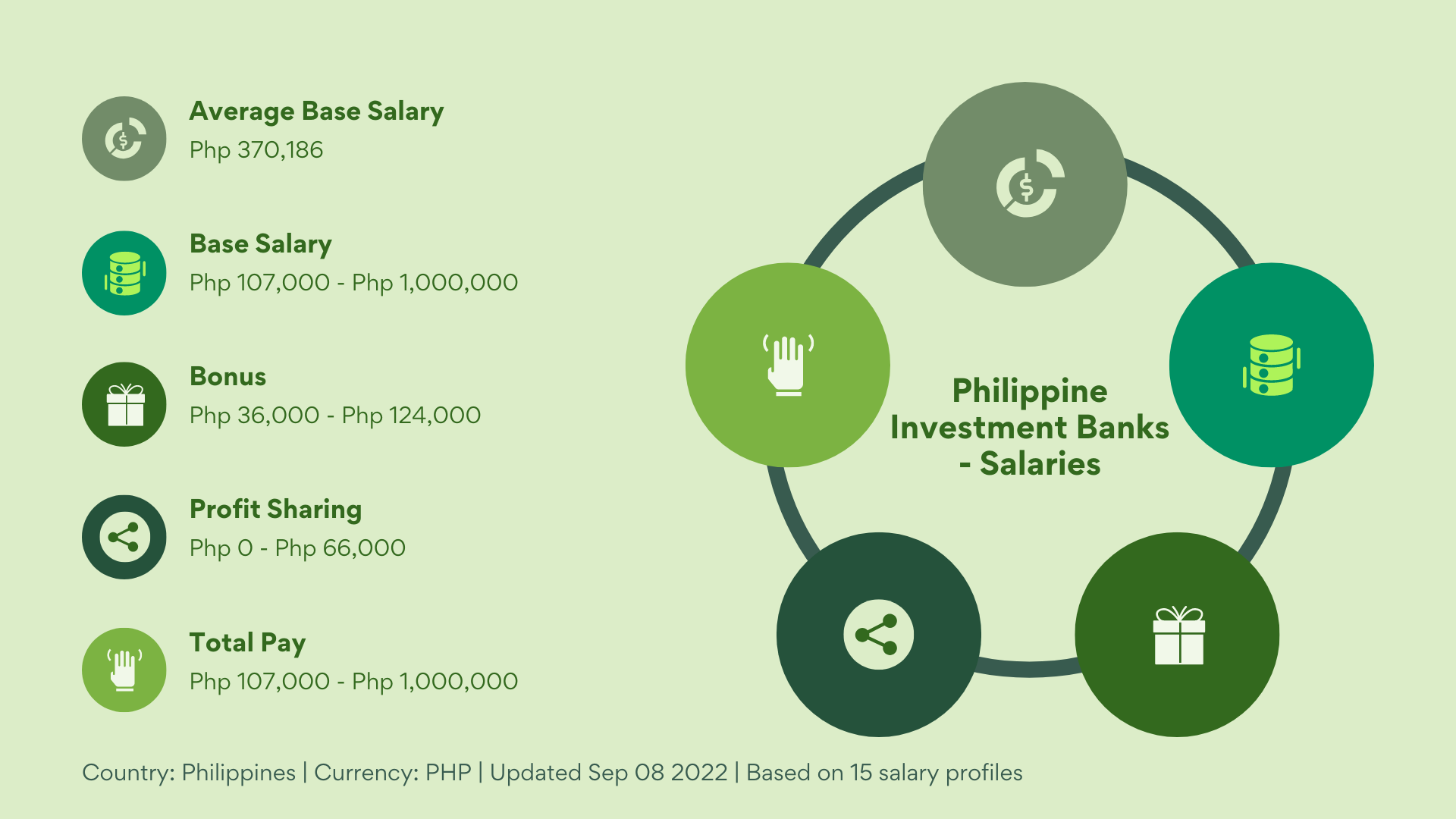Financial, Working class
Investment Banking in the Philippines

The Function of Investment Banks
How frequently have you heard big businesses buying up other companies? Joining forces with them by acquiring the most significant market shares? You must have questioned how these businesses decide when and where to invest a considerable sum of money to get the best returns. Therefore, investment banking is helpful in this situation.
The area of financial services known as investment banking seeks to raise capital for small-time investors, significant enterprises, and governments. Additionally an investment bank is a middleman for large, intricate financial transactions, which it facilitates.
Mins to Read: 14 minutes
Age: 18-60 years old

In this article, we’ll discuss the following:
What is Investment Banking?
Investment banking is a branch of banking that coordinates massive, intricate financial transactions like mergers or the underwriting of initial public offerings (IPOs). In addition to underwriting the issuing of new securities for a corporation, municipality, or other entity, these banks may raise money for businesses in several different ways. They might oversee an IPO for a company. They will offer guidance on reorganizations, mergers, and acquisitions.
Investment bankers are professionals who are acutely aware of the state of the market for investments. They assist their clients in navigating the difficult high finance industry.
The banking industry in the Philippines is quite diverse, and various banks and non-banking companies provide a wide range of services.
- There are 57 thrift banks, 492 rural banks, 36 commercial banks, and more than 6000 non-banking institutions and 40 credit unions.
- The Bangko Sentral ng Pilipinas was founded to oversee and manage these banks. This centralized authority was established in July 1993. It was established in accordance with the 1993 New Central Bank Act and the 1987 Philippine Constitution.
- The Bangko Sentral ng Pilipinas was created to oversee all banks and assist them in making the best decisions.
- According to Moody’s analytics, the Philippines’ banking industry appears to be doing well. The way the Philippine central bank has reduced the impact of inflation over the years is the most significant aspect for which Moody’s Analytics has been quite optimistic about the country’s banking sector.
Understanding Investment Banking
Investment banks work with institutions and private investors on mergers, acquisitions, reorganizations, and the sale of securities. They also underwrite new debt and equity securities for all kinds of firms. Investment banks advise issuers on the offering and placement of stock as well.
Investment banks generally support significant, complex financial transactions. If the investment banker’s client is considering an acquisition, merger, or sale, they might offer guidance on how much a firm is worth and the best way to organize a deal. The duties of investment banks may also include drafting the paperwork required for a company to go public and issuing securities to raise capital for the client groups.
Because investment bankers are professionals who have their finger on the pulse of the present investing climate, businesses and institutions turn to investment banks for guidance on effectively planning their development. Investment bankers can modify their advice based on the situation of the economy.
An Investment bank employ investment bankers to assist businesses, governments, and other organizations with the planning and managing of significant projects. Investment bankers help their clients save time and money by detecting project risks beforehand.
The Function of Investment Banks
An investment bank and a bank’s investment banking division (IBD) can occasionally be confused. Underwriting, mergers and acquisitions, sales and trading, equities research, asset management, commercial banking, and retail banking are just a few of the many services provided by full-service investment banks. A bank’s investment banking section provides only underwriting and M&A consulting services.

Investment Banking Underwriting Services
Underwriting refers to acquiring money by selling investors stocks or bonds (such as in an IPO) for businesses or other organizations. Companies require capital to run and expand, and bankers assist them in obtaining that capital by pitching the business to potential investors.
Underwriting typically comes in three different forms:
- Firm Commitment – The underwriter guarantees that they will purchase the entire issue and be fully responsible for any unsold shares.
- Best Efforts – The underwriter agrees to sell as much of the issue as is reasonably achievable at the agreed-upon offering price but is free to return any shares that are not sold to the issuer without incurring any costs.
- All-or-Nothing – The transaction is canceled, and the issuing company receives nothing if the entire issue cannot be sold at the offering price.
The following book-building procedures are used to price and close the deal after the bank has begun promoting the offering.

M&A Advisory Services
The practice of assisting corporations and institutions in locating, assessing, and completing business purchases is known as a mergers and acquisitions (M&A) advisory. This performs a crucial role in i-banking. Banks leverage their wide-ranging relationships and networks to identify possibilities and support client negotiations. Bankers operate as either the “buy-side” or the “sell-side” of an M&A transaction, assisting both sides.
The 10-step mergers and acquisitions procedure is summarized here.

- Acquisition Strategy – The foundation of a successful acquisition strategy is the acquirer’s understanding of the benefits they intend to derive from the acquisition and the rationale behind why they buy the target company.
- Acquisition Criteria – Choosing the essential standards for selecting potential target businesses.
- Target search – The acquirer searches for and assesses possible target businesses using the search parameters they have decided upon.
- Acquisition planning – The acquirer contacts one or more companies that fit its criteria and seem to be a good bargain. The initial discussions aim to gather additional information and gauge the target company’s amenability to a merger or acquisition.
- Valuing and Evaluating – Assuming initial contact and conversations go well, the acquirer requests detailed information from the target company (current financials, etc.). This information will allow the acquirer to more thoroughly assess the target as a stand-alone company and a potential acquisition target.
- Negotiation – The acquirer should have enough information to create an acceptable offer after creating numerous valuation models of the target company. After the initial request is made, the two parties can further discuss the terms.
- Due Diligence – Due diligence is a thorough process that starts as soon as the offer is accepted. Due diligence aims to confirm or correct the acquirer’s estimation of the target company’s value by conducting an in-depth examination and analysis of every aspect of the target company’s operations, including its financial metrics, assets, liabilities, customers, human resources, etc.
- Purchase and Sales Contract – Executing a final contract for sale after the parties have decided on the type of purchase agreement, such as whether it will be an asset acquisition or a share purchase, is the next step in the process.
- Financing – The acquirer will have undoubtedly looked into financing options for the transaction earlier. Still, financing specifics often focus after the buy and sale agreement has been completed.
- Closing and Implementation – After the purchase agreement is signed, the target and acquirer’s management teams begin to merge the two businesses.
Full-service banks provide the following services:
- Underwriting – Capital-raising and underwriting organizations work with businesses looking to raise capital or go public through the IPO process. The primary market, or “new capital,” is served by this function.
- Mergers & Acquisitions (M&A) – Advisory responsibilities for both business buyers and sellers, overseeing the M&A process from beginning to end.
- Sales and Trading – Connecting secondary market buyers and sellers of securities. Investment banking sales and trading teams can trade the company’s own funds in addition to acting as clients’ agents.
- Equity Research – The research, or “coverage,” of securities conducted by the equity research group supports stock trading and assists investors in making investment decisions.
- Asset management – The process of overseeing assets for a variety of clients, including institutions and private individuals, in a wide range of investment strategies.
Investment Banking Clients
Investment bankers provide extensive clientele with capital raising and M&A advice. These customers can be found anywhere in the world.
Clients of investment banks include:
- Governments – Investment banks assist governments in the funding of projects, the trading of securities, and the acquisition or disposal of crown enterprises.
- Corporations – Bankers work with private and public firms to assist them in going public (IPO), raising additional capital, expanding their operations, making acquisitions, selling company units, and providing research for them and general corporate finance guidance.
- Institutions – To assist them in trading securities and offering research. Also banks collaborate with institutional investors who look after other people’s money. Additionally, they assist private equity firms in acquiring portfolio companies and exiting those positions by either selling to a strategic buyer or making an initial public offering (IPO).
Investment Banking Skills
Work in investment banking necessitates extensive financial modeling and valuation. Bank Analysts and Associates spend a lot of time in Excel creating economic models and applying different valuation techniques to advise their clients and close agreements, whether for underwriting or M&A activity.
The following abilities are necessary for investment banking:
- Financial modeling – Involves carrying out various financial modeling tasks, including creating 3-statement models, discounted cash flow (DCF) models, LBO models, and other economic models.
- Business valuation – Employing various approaches, including comparable company analysis, prior transactions, and DCF analysis.
- Pitchbooks and presentations – Construct PPT presentations and pitchbooks from the ground up. Offer ideas to potential clients and secure new business.
- Transaction documents – Creating a data room, drafting a confidential information memorandum (CIM), an investment teaser, a term sheet, a confidentiality agreement, and many other papers (see CFI’s library of free transaction templates for a complete list).
- Relationship management – Involves working with current customers to close deals and ensure that they are satisfied with the service received.
- Sales and business development – Constant meetings with potential customers to present ideas, assist with tasks and offer added-value counsel that will ultimately result in new business.
- Negotiation – Assisting clients in maximizing value generation and playing a significant role in the negotiation strategies buyers and sellers use in a transaction.
Investment Banking Careers
While investment bankers are the most prominent positions at an investment bank, numerous more occupations in investment banking support the bank’s ability to efficiently, accurately, and securely raise capital for businesses and governments. The Investment banking positions include:
Investment bankers
Investment bankers seek cash and offer financial advice. They collaborate with customers to underwrite securities, locate and coordinate M&As, and develop economic models to assist in decision-making.
Brokers
Between buyers and sellers, brokers operate as a middleman. For instance, they assist in locating investors to purchase assets in investment banking.
Actuaries
Actuaries assess the risk associated with financial decisions and forecast how certain circumstances might impact a company’s finances.
Accountants
Accountants monitor and document a company’s financial activity and commercial dealings.
investment specialists
Investment advisors advise clients on managing and investing their portfolios to getting the best results.
But there are other additional, non-finance-specific career possibilities in investment banking. Banks require support personnel like engineers and information technology specialists to keep things running efficiently, just like any large corporation. Banks also require office managers, secretaries, and assistants to streamline office operations.
Investment Banking Recruitment Process
Any finance professional can earn pretty well working in investment banking. But unlike other investment banks in different nations, much attention is paid to work-life balance. Because of this, the ideal way to start an investment banking career in the Philippines is to apply for an internship. Choose one of the country’s leading investment banks and work your way up to associate status.
When applying for a job in investment banking, you should look for a few factors, including:
- How the investment banking firm views to experience and how much professional development you might receive while advancing your career there.
- Whether or if there is any paid training available.
- The investment bank offers life insurance, health benefits, and retirement plans.
- Whether there is a paternity or maternity leave option accessible should one be needed shortly.
The most crucial factor to consider is how successfully you will link your professional development with your family’s objectives. Every professional in the Philippines wants a healthy work-life balance because family is one of the most significant factors.
Philippine Investment Banks’ Culture
Culture has a significant impact on a career in investment banking. For this purpose, the investment banking profession is addressed very differently in the Philippines. Since international banks make up majority of the banks in the Philippines, there’s a blend foreign cultures in investment banks. Investment banking professionals put in between 80 and 100 hours each week due to a strong work ethic.
Professionals in the investment banking industry also value tradition and history. The importance of striking a balance between work and family time is due to this.
Philippine Investment Banks – Salaries
Philippines labor is renowned for being inexpensive. The salary of investment banking expert in the Philippines is low, which is the most terrible aspect of the industry.
An investment banking firm’s average salary is PHP 370,186/year. Investment banking experts in the Philippines earn about USD 6000 per year for less than ten(10) years of expertise. This is compared to millions made by their counterparts in the US and Europe.
However, your income may increase significantly if you advance and manage to land a position as a partner at a reputable investment bank.
Here is a graph made by PayScale that could be useful:

MUST-READ AND SHARE!
2023 Your Practical Wedding Guide
Your Ultimate Access to Kuwait Directories in this COVID-19 Crisis
Investments and Finance Ultimate Guide
OFW FINANCE – Money News Update that you need to read (Table of Contents)
A Devotional for having a Grateful Heart
Stock Investment A Beginner’s Guide
How To Save Money Amidst Inflation
Philippines Best Banks with High-Yield Savings Return
Essentials Before Applying For a Credit Card
If you like this article please share and love my page DIARYNIGRACIA PAGE Questions, suggestions send me at diarynigracia @ gmail (dot) com
You may also follow my Instagram account featuring microliterature #microlit. For more of my artworks, visit DIARYNIGRACIA INSTAGRAM



Peace and love to you.